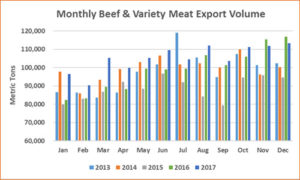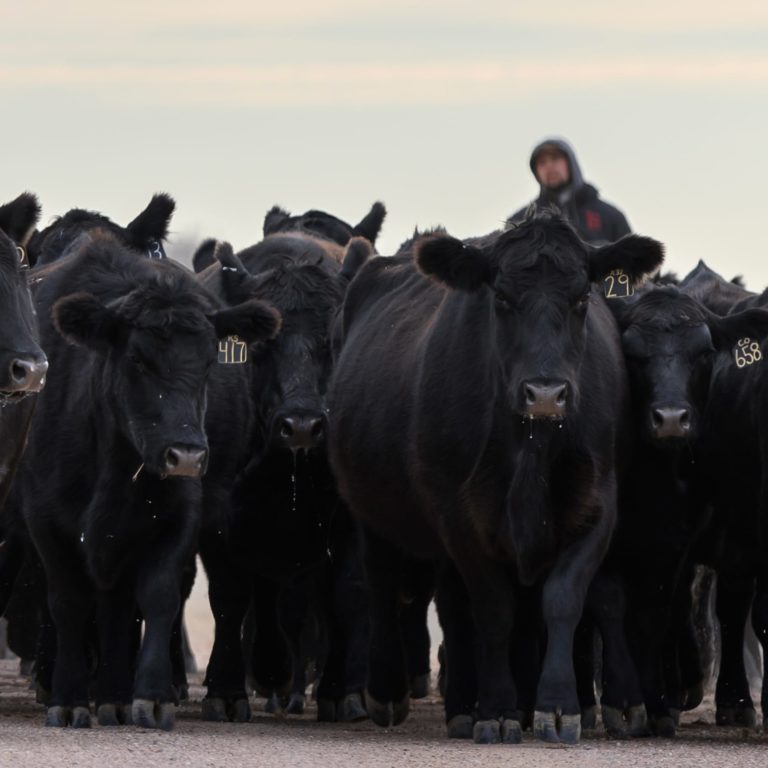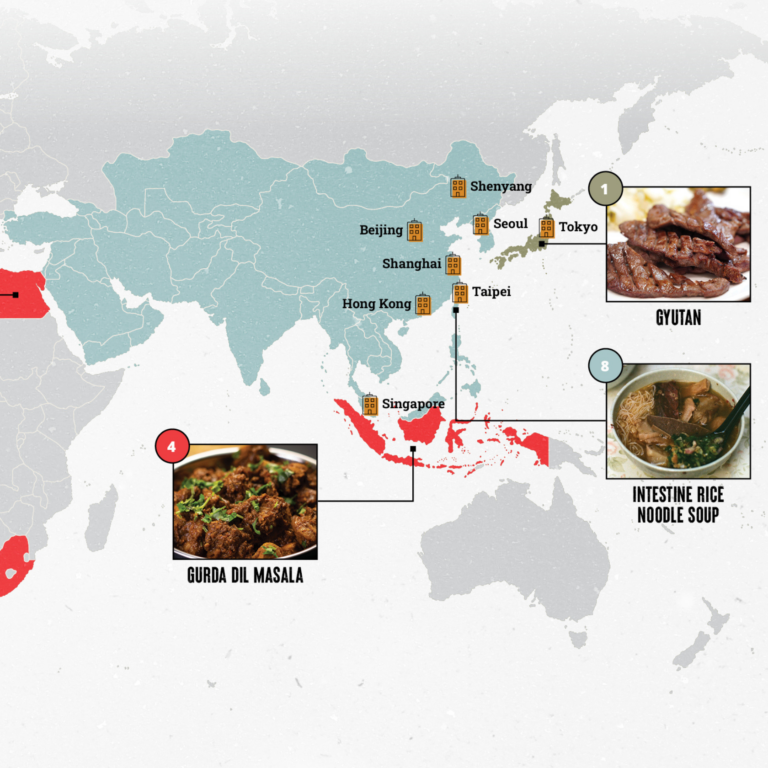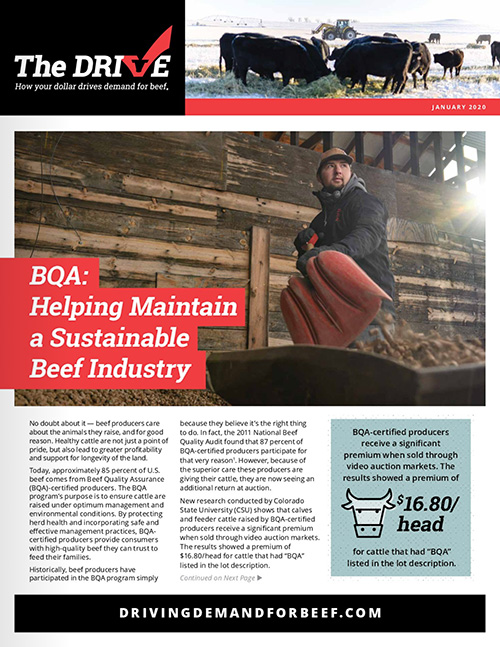
USMEF: U.S. Beef Exports Set New Records in 2017
Press Release via U.S. Meat Export Federation
Calendar year 2017 was a record-setter for U.S. beef exports, with values exceeding $7 billion for only the second time.
Beef exports totaled 2.8 billion pounds, up 6 percent from 2016. This was the fourth-largest volume on record and the second-largest of the post-BSE era. Beef export value reached $7.27 billion, up 15 percent year-over-year and 2 percent above the previous high achieved in 2014 (to $7.13 billion).
For December only, beef export value was up 9 percent from a year ago to $672.9 million – the second-highest of 2017 and the third-highest on record. December volume was down 3 percent from a year ago to 249.7 million pounds.
Beef exports accounted for 12.9 percent of total production in 2017 and 10.4 percent for muscle cuts, down from 13.7 percent and 10.5 percent, respectively, in 2016. Beef export value averaged $286.38 per head of fed slaughter, up 9 percent from 2016 and the second-highest on record, trailing only the $300.36 average posted in 2014.
Japan leads beef export growth; value records fall in other key markets
Japan solidified its position as the leading market for U.S. beef in 2017, with volume climbing 19 percent year-over-year to 678.1 million pounds and value up 25 percent to $1.89 billion – new post-BSE records. Chilled exports to Japan expanded even more rapidly, reaching 327.8 million pounds (up 32 percent) valued at $1.102 billion (up 37 percent) as U.S. beef captured more than half of Japan’s imported chilled beef market – a new high for U.S. market share. Japan accounts for nearly $75 in export value per head of fed slaughter and delivers critical premiums for certain cuts. For example, Japan’s imports of U.S. beef tongue averaged $12.13 per head and $26.44 per head for short plate.
The U.S. industry is marketing a wide range of beef cuts in Japan and the market holds potential for additional growth. But market access is a concern, with imports of Australian and Mexican beef subject to significantly lower duties and beef from Australia, Canada, New Zealand and Mexico all poised to gain further tariff relief through the Comprehensive and Progressive Agreement for Trans-Pacific Partnership (CPTPP).
Other 2017 beef export highlights include:
- Beef exports to South Korea increased 3 percent in volume (to 406 million pounds) and climbed 15 percent in value to $1.22 billion, easily outpacing the previous year’s record. Chilled U.S. beef rose, increasing 73 percent in volume (to 99.5 million pounds) and 78 percent in value (to $405.8 million). Demand is especially strong in the Korean retail sector, where consumer confidence in the quality and safety of U.S. beef continued to gain momentum. Korea’s imports of U.S. beef are now subject to a 21.3 percent tariff, down from 24 percent in 2017 and well below the 40 percent rate in effect prior to implementation of the Korea-U.S. Free Trade Agreement (KORUS). The tariff rate is scheduled to decline to zero by 2026.
- Mexico remained the second-largest volume market (524.6 million pounds, down 2 percent from 2016) and third-largest in value ($979.7 million, up slightly). It is an especially important market for U.S. beef shoulder clods, rounds and variety meat.
- Exports to Taiwan set a new value record, increasing 13 percent from a year ago to $409.7 million. Volume was up 2 percent to 98.8 million pounds. U.S. beef holds 72 percent of Taiwan’s chilled beef market, the highest share of any Asian destination. Taiwan is a key market for secondary beef cuts such as the clod, heart, petite tender and top sirloin cap.
- Demand in Hong Kong rebounded from a slow start to post a strong performance in 2017, increasing 16 percent in volume (288.2 million pounds) and 29 percent in value ($884.1 million). After China’s mid-year lifting of its ban on U.S. beef, exports to China totaled 6.7 million pounds valued at $31 million. While eligible supplies remain limited due to China’s import restrictions, the market holds significant growth potential and is already one of the highest value markets for U.S. beef on a per-pound basis.
- Record exports to the Philippines and Singapore and strong growth in Indonesia and Vietnam pushed up export volume to the ASEAN region by 37 percent to 90.3 million pounds, while value climbed 34 percent to $210.9 million.
- Strong performances in Chile, Peru and Colombia led the way for U.S. beef in South America, where export volume increased 24 percent to 62.6 million pounds and value was up 23 percent to $114.8 million. Shipments to Brazil, which resumed in April after a 13-year absence, totaled 4.5 million pounds valued at $7.4 million.
- Led by strong beef liver demand in South Africa, exports to Africa increased 78 percent in volume (to 48.5 million pounds) and 74 percent in value (to $22 million). Since reopening to U.S. beef in 2016, South Africa has emerged as the sixth-largest destination for U.S. beef variety meat and second-largest for livers.
The above data was released by USDA and compiled by the U.S. Meat Export Federation (USMEF), sub-contractor to the beef checkoff. Complete 2017 export results for U.S. beef are available on USMEF’s statistics web page. Monthly charts for U.S. beef exports are also available online.

If you have questions, please contact Joe Schuele at jschuele@usmef.org or call 303-226-7309.
The Beef Checkoff program was established as part of the 1985 Farm Bill. The checkoff assesses $1 per head on the sale of live domestic and imported cattle, in addition to a comparable assessment on imported beef and beef products. States may retain up to 50 cents on the dollar and forward the other 50 cents per head to the Cattlemen’s Beef Promotion and Research Board, which administers the national checkoff program, subject to USDA approval.
































































